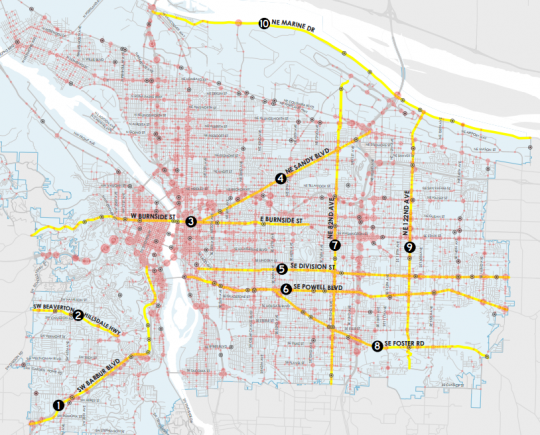
(Image: City of Portland)
As Portlanders continue to look for ways to change the culture of speed-oriented streets like Powell Boulevard, state legislators are nearing a vote on a bill designed to do exactly that.
As we reported back in March, House Bill 2621 would allow the City of Portland to install 20 automated, highly visible photo-radar cameras along its ten most dangerous streets, including Powell Boulevard.
In an email to safety advocates Monday evening, Portland Bureau of Transportation Operations and Safety Manager Gabe Graff wrote that “we’re hopeful” that the bill “will be headed to the floors of the Senate and House in a matter of weeks.”
The safety-camera bill is one of the city’s legislative priorities for the current legislative session. It’s also been endorsed by The Oregonian’s editorial board and is sponsored by state Reps. Jeff Reardon (D-Happy Valley), Chris Gorsek (D-Troutdale) and John Lively (D-Springfield).
The bill is currently before the House Ways and Means committee, but with possible floor votes nearing, the city is tentatively planning to urge supporters of the anti-speeding cameras to call or email their legislators in both the state House and Senate.
“Our 10 high-crash corridors are just 3 percent of Portland’s roadway system by lane-mile, and they account for 51 percent of our pedestrian fatalities,” Graff told us in March. “You look to other cities that have safer transportation systems than ours — New York, Seattle, Stockholm — they use these systems to great benefit.”
Advertisement
Some people have criticized the systems as public moneymakers. They would be. According to a state analysis of the bill, Portland would net $6.6 million over the next two years and about twice that in subsequent periods. The revenue would be earmarked for traffic safety, including enforcement, education and/or infrastructure.
According to the same state analysis, the cameras would also reduce excessive speeding by 61 percent over the next six years in the locations where they’d be placed.
Using figures from the National Highway Traffic Safety Administration that found a 20 to 25 percent drop in traffic collisions in areas where the cameras are installed, the city estimates that over the eight-year pilot period for the cameras, they would save 16 lives; prevent more than 2,000 people from being injured in traffic crashes; and save the economy $71 million in related wage and productivity losses, property damage and medical expenses.
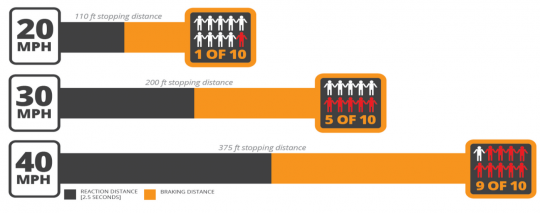
The state projects that the program would start with two cameras in January 2016, gradually scaling up to 20 cameras around the city by July 2018. All would be prominently marked in order to attract attention, Graff said.
In Oregon, someone convicted of speeding 1 to 10 mph over the limit faces a fine of up to $110. For 11 to 20 mph, it’s $160; for 21-30 mph, $260; and for 30 mph or more, $435. Like other court-issued penalties, many are routinely reduced through plea agreements. Graff said in March that in order to ensure that people aren’t victims of equipment error, people wouldn’t receive tickets unless they’re observed driving well over the limit.
Also this week, members of the advocacy group BikeLoudPDX have announced that they’ll hold a “die-in” Wednesday in front of the Oregon Department of Transportation’s Portland-area headquarters at 123 NW Flanders St. in Old Town, in “protest of the blood that has been spilled on ODOT’s high crash corridors.” It’s scheduled to begin at 4 p.m.
“White clothing encouraged but optional,” the organizers write.



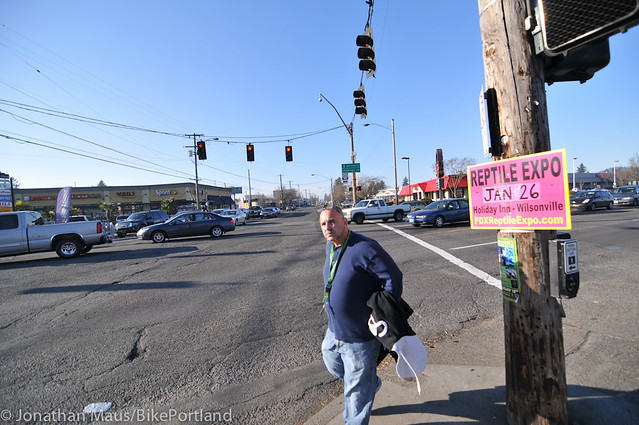
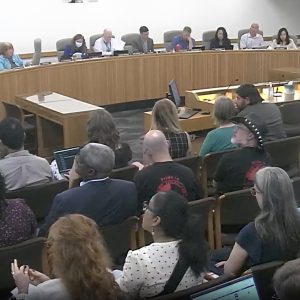
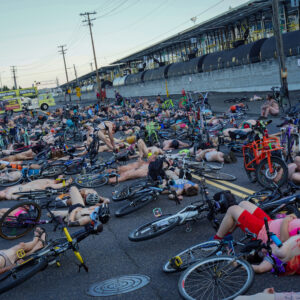
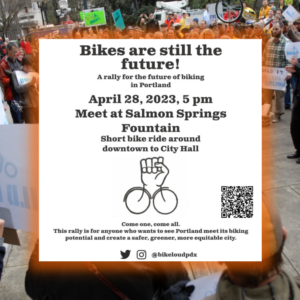
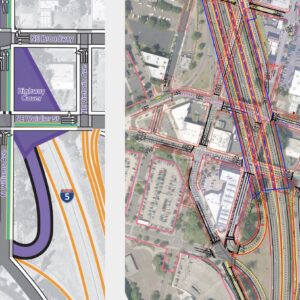
Thanks for reading.
BikePortland has served this community with independent community journalism since 2005. We rely on subscriptions from readers like you to survive. Your financial support is vital in keeping this valuable resource alive and well.
Please subscribe today to strengthen and expand our work.
Wish MLK were included on this list.
Great, the parts of Portland where people are least able to afford tickets. Iron Cops are not the answer and regressive as hell. In the Ferguson Justice Department report, one of the largest indicators of social inequity was the impact of little BS tickets on communities of color and how the tickets compounded into more serious offences that often resulted in jail time (i.e. going to jail because you had a cracked windshield and couldn’t afford the fine).
We need to not use this as an excuse to put a new revenue stream in, rather we should be demanding better engineering of the streets, better enforcement of the existing laws and more emphasis at education for both drivers and riders. Remember drivers ed in the old days?
Or…people could choose not to speed and then receive no speeding tickets.
Oh wait, that’s exactly the whole idea behind these cameras.
“We need to not use this as an excuse to put a new revenue stream in”
And how do you know that this is ‘the reason’? What if people actually learn to drive better, pay more attention to their speeds with these posted in especially dangerous locations? What if the money raised went toward offsetting the damage now done by people speeding? I don’t see why we have to throw the baby out with the bathwater here.
The safe systems/vision zero approach to roadway safety works from several points of attack to eliminate fatal and serious injury crashes.
Better enforcement and better laws are illustrated in this effort.
I hope the projections of revenue took into account past experience at other metro agencies, where the projections were larger than the actual revenue, because people slowed down.
http://www.washingtonpost.com/local/dc-politics/declining-traffic-camera-revenue-threatens-to-unbalance-dcs-budget/2014/09/29/245ce9aa-4821-11e4-b72e-d60a9229cc10_story.html
http://chicago.suntimes.com/chicago-politics/7/71/168607/emanuel-essentially-says-i-told-you-so-about-speed-cameras
I recall the main speaker at the bike summit indicated a similar issue in NYC.
here’s another:
http://www.sheepsheadbites.com/2014/07/revenue-camera-enforcement-nyc/
The worst aspect of the Ferguson policing methods was the fact that POCs were targeted disproportionately for any given violation. Automated speed cameras don’t care who you are; only what speed you’re going.
Not only that, but these high speed streets are doing real damage to the disadvantaged communities they run through. People who live there benefit more from having safe streets than they lose from paying fines.
As I understand this bill, iron cops are rarely involved. While I agree the effect on poverty needs to be addressed, these are just plain cameras, not racial profiling cameras.
BH Highway has lots of traffic from Beaverton and expensive homes.
But I would contend that the speeders are people passing through the neighborhood on their way to their more affluent neighborhood and they have little regard for quality of life for someplace that is simply a route to somewhere better…
So without data on who’s speeding and where they live that social justice aspect is a lot of speculation. And yes. Don’t speed. Easy. Justice issue resolved by the same means for everyone so it’s not really a justice issue, you know? It can be fixed by individual behaviour and the camera sees no color.
I drive slower and better in my own neighborhood. I admit it. So when I’m somewhere else I try to remember that, but…
“the parts of Portland where people are least able to afford tickets”
also the parts with the worse drivers… are you saying that poor people are bad drivers?
I don’t care…
if you’re speeding then you get a ticket… I have no pity for you getting a ticket, no matter your income level…
I would say that this will make the poor people drive better, and the rich people will continue driving poorly…
A good reform to all of our traffic laws would be to have fines be based on income – at the very least, proportional to income, but ideally truly progressive (higher percentages of income for people with higher incomes). However, I have a feeling that would be very complex legally, and a heavy legislative lift. I don’t think it’s worth delaying speed cameras until a better fine system can be pushed through the legislature. Don’t let the perfect be the enemy of the good….
lots of European countries do this: Rich playboy in million dollar sports car goes 120kph over the speed limit = $1M Euro fine and the car is impounded.
Here are some links:
http://en.wikipedia.org/wiki/Day-fine
http://www.sfgate.com/news/article/Speeding-fines-being-linked-to-income-in-Europe-3275939.php
http://autos.aol.com/article/highest-speeding-fines/
That’s long term stuff. Short term–stop the bleeding. I don’t care how heavy a hand the cops use on any damn driver.
The cameras are designed to achieve “better enforcement of the existing laws.” They appear to be a great answer to your concerns.
“Some people have criticized the systems as public moneymakers.”
Don’t want to give money to the city? Then don’t endanger others with your automobile by speeding. Is that so hard?
The simple solution is to have the money go to a party that has no say in where the cameras are installed. For example, let the city decide where the cameras are located, but send the money to Salem. That reduces the temptation to use them for other-than-safety purposes.
I don’t follow the logic, if any.
How does providing a new source of revenue to a body of people that, for the most part, don’t support Portland’s vision for the future, insure that the system is not abused?
And isn’t it a bit cynical to imply that PBOT is not interested in safety? The proposed bill requires the ‘profit’ money be spent on safety.
PBOT has already demonstrated it’s ability to appropriately install fixed cameras with the red-light enforcement. PBOT installed them where the most red-light violation crash events were occurring, not where the most violations were occurring, as recommended by the camera vendor.
As I have written before, I think it is a terrible idea to give a governmental body (like the city) a financial motive to enforce certain laws over others. Perhaps the current administration can resist the temptation that presents, but I have no confidence that that will remain true forever.
Decisions about law enforcement should be completely divorced from decisions about collecting revenue.
Yes, they should be left up to apathy, whim and prejudice as they are now.
Wait… we KNOW that doesn’t work. Hmmmm….
The worst part I see is that such a funding stream is as inherently unreliable as the a cigarette tax is.
We know from history that every implementation of a tax or fee that targets a certain action or behavior leads to a reduction of that behavior and, if the financial penalty is high enough, its almost complete elimination.
Where this becomes bad is when a legislature eliminates a school’s normal funding source and replaces it with, say, a cigarette tax revenue stream. It might start out higher but eventually schools are left begging for their original funding source back from years ago. In the mean time that money is gone; dedicated somewhere else to something else important.
The biggest mistake we can make with traffic camera revenue is to treat it like a reliable source of income. If the ticket revenue stream doesn’t drop over time it is only because the fine is not high enough to be a deterrent.
It’s OK with me if higher fines or taxes lead to a decline in both speeding and cigarette usage.
If the revenue is dedicated to a worthy cause, such as schools, and declines, we simply need to pick the next undesirable behavior and levy taxes and fees against that. I’m not seeing a lack of evil behaviors that are possible subjects for behavior modification through taxation and fees.
Going further, it is the revenue sources that prey on people’s weaknesses that deserve further scrutiny. ‘Sin’ taxes often target addictive behaviors, so could have a health benefit, but what about revenue from gambling? That seems like a conflict of interest for a government.
“…the fine is not high enough to be a deterrent.”
Some psychologist or sociologist or game theorist can correct me here, but I would be that a guarantee of a fine, even if it is relatively small, is a bigger deterrent than a small probability of a large fine. Even rich folks don’t want to pay, e.g., $50/day for the privilege of speeding past a camera.
Brilliant! Bravo!
30 mph or more, $435
So 55 (or 75) in a 25 is less than $500. Considering the willful danger to the public, wouldn’t loss of vehicle, license, and community service be more appropriate.
If everyone’s lucky I’m guessing it would be a traffic violation, but regardless, a speeding ticket would be the least of the driver’s concerns.
It would be more fair if the fine were a percent of last annual gross income. 1% of a 50k income is $500. 1% of a 100k income is $1,000.
IIRC, 50 or 75 in a 25 is >=2x the speed limit and can result in arrest and impounding the vehicle. Exceeding by >=30mph with a previous record can result in suspension.
The one that doesn’t make sense is that infractions in zones 65mph or greater are one level more serious. So it’s worse to drive 75mph in a 65mph than to drive 35mph in a 25mph.
Mark your calendars for the reptile expo on Jan 26th.
Huh?
The constantly reused picture of 82nd and Foster in the article. Its been in at least 4 stories now.
Oh. I grew up on Star Trek so I don’t even see over-recycled backgrounds.
I am sure that this will pass now that John Davis (R) has changed his ways from voting against distracted driving laws to advocating for safer streets.
Someone doing that is likely to also recieve a reckless driving or negligent driving or worse kind of ticket I would imagine.
Maybe I’m interpreting it incorrectly, but it appears to me that the only citation that can be issued using the cameras is for speeding.
Someone needs to show their work on that graphic. The reaction distance at 40mph would only be 2x the reaction distance at 20mph (146ft & 73ft.) It is drawn at ~3.5x, which makes the 375ft very suspicious. Yet, the yellow part (braking distance) should be 4x because v^2.)
Meanwhile, anyone with a 2.5s reaction time better be leaving a 5s gap to the vehicle in front of them: 145ft at 20mph.
Speaking of linear relations, why are the fines stepped at 10mph and not 20%? Allowing 30 in a 20 undermines our greenways.
Perhaps cameras should have strict enforcement with 1 probationary ticket in the first 5mph (don’t have to pay until the 2nd, then you pay both.) Also, maybe immediate e-mail or text notifications of pending fines.
I am always so surprised by the apparent inaccuracy of the speed measurement in these devices. Can we really not build one that has a deviation of less than 5 mph? Or are there other, more political, reasons why we set the bar at 10mph?
I think the real problem is that automobile speedometers are not always accurate, so they allow some leeway for that. I know that the speedometer in my car consistently reads 10% faster than my actual speed, even though the odometer is accurate. Also, if people change tire sizes on their cars, the speedometer and odometer will no longer be accurate.
They’re usually set to read high though. If the device is +/-5% the car manufacturers set it (its just a small replaceable gear) 5% fast so no one can claim they got a ticket while their speedo was reading the speed limit.
We can build very accurate speed measurement devices. Police carry them, and they require calibration, routine maintenance, precise aiming, and a lack of interference and multipath reflections. A poorly-maintained device hanging off a utility pole in all manner of weather and situational conditions does not enjoy such provable (because it has to stand up in court…) precision and accuracy.
It’s certainly theoretically possible to build a “smart” system that actually identifies the moving objects frame-to-frame, that can target and discount interference, and can self-adjust, correct parallax, and calibrate based on fixed landmarks in view. (Basically, the same problems autonomous cars have to — and do — solve.) It wouldn’t even need to use radar. But I’m not aware of any devices that actually do this. I think what’s out there today is basically dumb Dopler-pingers.
During my career I used a few different radar guns and found all to be extremely accurate (at least when tested against each other in known conditions) and easy to use. I think the “apparent inaccuracy” is an urban myth.
There’s no doubt in my mind that the 10 mph “cushion” customarily applied is for purely political reasons. That’s the same reason they put up the advance warning signs that say “Crosswalk Enforcement Ahead.” The police don’t want judges throwing out their citations so they provide plenty of extra margin even when it isn’t really needed.
As you think about the possibility of unreliable electronic devices, consider when was the last time your bank’s ATM machine gave you the wrong cash. It hasn’t happened to me yet.
Eric,
You seem to be confused about the state of technology. license plates machine read and databases linked to the registered owner’s current e-mail? You confuse ODOT and PBOT with the NSA.
First, most of the film is now digital but it is not an AI computer watching the streets, just a camera.
Second the photos are reviewed by the contractor for accurate full face photos and gender match with registered owner. If the genders don’t match, the owner is requested to identify the driver – same if the registered owner denies driving the vehicle. Verified photos are sent to the police for confirmation and mailing of citations.
It’s not as far-fetched as you might think… Portland has used automated plate-scanners before — http://www.kgw.com/story/news/2014/07/25/12547386/
References for stopping sight distance:
top table:
http://www.ccgov.org/uploads/PublicWorks/AASHTO%20Intersection%20_%20Stopping%20Sight%20Distances.PDF
page 23:
http://www.oregon.gov/odot/hwy/accessmgt/docs/stopdist.pdf
Scary to see that even 2.5s only covers reaction time for 95% of drivers.
I’ve already requested some for East Burnside, but I did not know there would be a limited number of them. 20 is NOT enough for our High Crash Corridors.
Those braking distance numbers are complete and total, self-serving BS. Flat out lies. For starters, a 2.5 sec reaction time is bogus. Count it out and see how long that is. 1.5 seconds, for both perception and then moving your foot to the brake, is more realistic for anyone paying attention. And it’s faster if you left foot brake, like people should, especially if you drive an automatic (again, better driver education is needed).
But using their 2.5 seconds, at 40mph (or 58.6fps), 2.5s equals 146.5ft traveled. Subtract that from their stated 375ft stopping distance and you get 228.5ft to actually stop the car. BS. Cars and SUVs can stop from 60mph faster than that. The longest it took a 2011 midsize SUV to stop from 60mph was 150ft (1).
All this crap is just overblown scare tactic garbage. You’d think that little kids were getting mowed down daily as they walk to school and all you people are just eating it up and feeding into it. Try making policy with thought for once, and not fear. It’s very rewarding.
1. (http://www.consumerreports.org/cro/magazine-archive/2011/april/cars/best-and-worst/breaking-distance/index.htm).
The consumer reports is dry pavement though.
Still, the PBOTs graphic is wrong enough on reaction time alone.
you might be correct for a panic stop with a driver at full attention on the roadway and driving.
the first condition is not uncommon, but only because the second condition is rare.
The 2.5 seconds is to include time to look up from your phone.
Cars are the number one cause of death for children.
I remember reading that 100% of the revenue generated from the speed cameras must go back into safety projects. Is this still the case?
Yep, as of a recent amendment to the bill.
Great! I think this is really important because it will nullify the whole “the city is just doing it for the money” argument.
It really doesn’t nullify that argument. Money is fungible, and $5M earmarked for safety means $5M that doesn’t have to be taken from general fund or somewhere else, which means $5M for some other pet project (whether deserving or not). Maybe camera placement could be based on a citizen committee?
Subjective criteria (my street is less safe) or objective (85th percentile 10 over posted)?
If objective, why do you need a committee?
BTW, the legislation specifies criteria for which street corridor can have fixed photo speed enforcement.
Marine Dr.
I was on a motorcycle indicating the speedlimit (so uhh, actually a few under) and I was passed by 4 cars in a row over a double yellow. No, they did not pass and then maintain the speedlimit. 20 over in a place where at least 2 cars have gone swimming this year.
A age old tradition in high taxation Europe is to not own anything. Instead, people work for companies for a lower salary and then they are provided with a company car, company house, etc. This way your taxable income is much lower. there is always a way around the process if you have a smart enough lawyer or accountant. Yet another of the hurdles between rich and poor and the regressive nature of tax structure designed to implement social policy.
And most of Europe is clearly suffering???
I testified before the House Committee for this bill in March, along with several PBOT staff members and a couple other civilians. Everybody was very passionate and thoughtful about this, even the questions from the legislators. After 3+ years of looking, listening, advocating, and being driven by others, I support these efforts to reduce speeding. Even though everybody I am ever a passenger with knows the effort I put into making the streets safer and that my son died after being hit by a car, they still run lights and stop signs, speed, tailgate, use their phone, don’t maintain their lane, etc., WITH me in the car. (They don’t each do all). Even I have trouble being as safe as I could be, though I’m much better. Sometimes we all need reminders and consequences to learn. You’d think your son losing his life would be enough of a lesson forever, but no.
Kristi,
thank you for doing all that you do!
Your descriptions of how the people you ride with drive is exactly why I have been harping on what a poor fit the car is. All those behaviors on a bike or roller skates or on foot would be unlikely to harm anyone seriously, but put us in cars, and we’re easily overwhelmed, able to get where we’re going without incident by luck more than skill.
Driving tests should include a literacy test on two-digit numbers. Very simple, dummies–your car has this gauge. If you can’t make the gauge match the signs on the side of the road, you don’t get to drive. Simple.
It’s not lack of skill that leads to speeding. And in many cases I bet it’s not even lack of awareness. It’s impatience coupled with risk acclimatization. Accidents are rare, so having done something (speeding) a hundred times before without incident, one easily begins to think it can be done a hundred times again without incident. The more rare the phenomenon, and the more frequently one is exposed to the risk, the more likely unsafe behavior is thought of as safe.
The solution is not a skill demonstration; it’s correcting the cumulative misperception of risk (through education) and ingraining fastidious safety habits so that habits and practiced routine override the impulse to take greater risk.
Agreed. Most road users have never been in or seen a crash, so they have a knowledge gap. They don’t know how fast things can go wrong.
“The solution is not a skill demonstration; it’s correcting the cumulative misperception of risk (through education) and ingraining fastidious safety habits so that habits and practiced routine override the impulse to take greater risk.”
That would be a good strategy. But you are implicitly arguing that with enough training we (all of us) can get good at this. I’m not holding my breath.
We could get a lot better at it.
Imagine, instead of drivers ed taking place wherever the instructor thinks its safe enough to take a new driver, we had good simulators available where we could actually put the drivers in real danger? You could program in drunk drivers, ice, bikes coming up in the right hand bike lane.
You could even have retesting every few years in a much more realistic situation than a parking lot.
Yes, this! Good simulators (ones that trick the driver into actually feeling the momentum and response of the vehicle) are really expensive, which is why we don’t do it. But I think it would make a huge difference, and if we mandated that level of education when training drivers, there would be enough demand to a company/companies who could specialize and invest in simulators and good instruction.